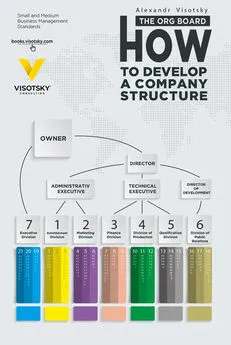Александр Высоцкий - A Job Description for the Business Owner
- Название:A Job Description for the Business Owner
- Автор:
- Жанр:
- Издательство:неизвестно
- Год:2019
- ISBN:978-1-5404-2202-6
- Рейтинг:
- Избранное:Добавить в избранное
-
Отзывы:
-
Ваша оценка:
Александр Высоцкий - A Job Description for the Business Owner краткое содержание
A Job Description for the Business Owner - читать онлайн бесплатно ознакомительный отрывок
Интервал:
Закладка:
However, at the time the company was founded, my partners and I had the motives of a Vaishya—each of us was thinking of increasing personal wealth. That is why, upon achieving some success, the company stopped growing. At the time, I did not realize why that had happened. After operating for three years, I noticed that our competitors had surpassed us, and that it was important for us to expand. But in all of my attempts to reform the company, I encountered resistance from my cofounders. My partners held key executive positions, and as they were satisfied with the company's current level of performance, I was unable to pass my ideas on to them. Neither the other company owners nor I actually understood our functions, nor the tools for growth that were at our disposal. Eventually, after my attempts to turn the situation around were defeated, I left the company. I departed with my chin held high and made a promise to myself: There is no way in hell I will ever have business partners again. In that moment, I had not yet realized that it was my own incompetence that was the reason for my failure. One could say that the inner, adventurous Kshatriya had awakened in me, but my own incompetence had led me to defeat.
Since then, I’ve had many conversations with various company owners and have come to the conclusion that only a small number of them start out as Kshatriyas. Modern culture, at best, aims to raise obedient and hardworking executors, rather than develop leaders. Characteristically, a leader is fanatically loyal to his goals and persistent in their achievement. In his book, Grinding It Out: The Making of McDonald’s, 1 1 Another book about McDonald’s I suggest all business owners read is McDonald’s: Behind the Arches, by John F. Love (New York: Bantam Books, 1986).
Ray Kroc wrote:
Press On: Nothing in the world can take the place of persistence. Talent will not; nothing is more common than unsuccessful men with talent. Genius will not; unrewarded genius is almost a proverb. Education will not; the world is full of educated derelicts. Persistence and determination alone are omnipotent.
Yet when children are raised in a civilized society, the first thing they learn is to follow the rules. While doing so may make children socially comfortable, it also often suppresses their leadership traits. A child wants to play, but he is forced to go to bed; he wants to get on top of the dresser and jump onto the bed, but his parents don’t encourage such acrobatics. Of course, you should not let your children do whatever they want whenever they want—after all, your job is to keep them from harm. But keep in mind that all the behavioral rules imposed by the society, while nurturing, also tend to destroy leadership abilities.
My daughter attended a children’s group at a music school, and during one class I noticed a girl who was behaving like a robot. She did everything the instructor asked her to without showing any initiative. Frankly speaking, I felt sorry for her. I realized that this little three-year-old girl had already abandoned all hope of having a say in what happened in the world around her. At the end of class, her mother arrived—the nicest woman in every respect—and, with pleasure, took a seat next to her daughter and started helping the instructor. The way she treated her daughter shocked me. When her daughter dropped a toy she was playing with, she timidly reached out to pick it up. Before she could even finish doing so, her mother told her, “Don’t pick it up. Keep playing.” When the girl started playing with a different toy, her mother immediately responded by saying, “Dear, pick up your toys!” And when the girl hesitated a little again, her mother instantly gave her a new instruction: “Sweetie, go dance with the other kids.” Thank God she didn’t control her daughter’s breathing—it is probably the only reason the girl is still alive! After watching this, my only wish was that the instructor would keep this woman far away from my daughter and the rest of the kids.
It is amazing to me that people raised in a “civilized” and conformist society still aspire to achieve anything. In my opinion, the desire to achieve is the reason many business owners, while in the process of growing their business, go through an evolving set of goals. Starting with the desire to provide themselves and their families with comfortable living conditions, they eventually discover the desire to achieve something more. I am no exception. Having started a business to create a source of income and opportunities for professional growth, I, too, eventually realized that I wanted to create a really big business game. For whatever reason, it seems that many of us first need to see that we are capable in order to become inspired to create something really worthwhile. From the moment we are born, the world tries to convince us that the only way anybody can become a somebody is by following the rules and being controlled by someone else. It is therefore vital that you come to realize your inner abilities in order to achieve something truly worthwhile.
Take, for example, people who enter the business world right out of school and start successful companies; they all share the same trait. Before going into business, they became experienced and comfortable at managing teams. It's really that simple. A student gets experience as a class president, a member of a student committee, or a project leader; and when the business world becomes accessible, she or he already has a basic understanding of the rules of the game. She knows people need well-defined and achievable goals. She knows people’s activities need to be coordinated, and she also knows a great secret: If you tell a person that something needs to be done and that person supports the group’s goal, he will do his best to make it happen.
Steve Jobs is an inspiring example of such a group leader. His subordinates claimed that he asked for the impossible—that his standards were too high, and that it was technically impossible to make his dreams come true. The engineers thought Jobs was crazy when he asked them to place the Macintosh LC inside a beautiful but tiny case. When Jobs came up with his legendary Macintosh Classic, he was told that nobody needed such a computer. Jobs pushed his employees to work eighty hours a week and did everything possible to help bring his ideas to fruition. He was so difficult to work with that in 1985 the shareholders decided to oust him. As a protest, Jobs sold all of his shares and started other projects. A series of strategically important mistakes for Apple while under the leadership of a CEO who knew about increasing profits but who operated far from the ideology of the company followed, until Jobs returned in 1996 to rescue a failing company.
In most cases, we need to go through a transformation that helps us realize our abilities, talents, and leadership potential. In fact, a person begins to feel the desire to become stronger than others only when he feels strong enough himself, becomes aware of himself as an individual, and recognizes his talents. That is why when we first start a business and build a team of like-minded people, we experience self-doubt and lack confidence in our abilities. The better our results are, and the more strongly we become convinced of our own abilities, the more evident is the desire to do things that will enhance the lives of other people. Therefore, in building a business, generating some revenues, and building a small team, we get confirmation of our own strength and gain the motivation to grow. So in the business owner is born a Kshatriya.
Chapter 2. The First Step to Competency
There is a god I am ready to pray to: the god of competency. Competence is a mixture of knowledge, practical abilities, and creative goals. If one of these elements is lacking, competence does not exist. One can tell whether a person is competent simply by looking at the results of what he has undertaken. If a man is a competent husband and father, his family thrives, his wife is happy, and he is proud of his kids’ achievements. If a business owner is competent, his company prospers and grows larger without any headaches. If you are interested in knowing just how competent you are as a business owner, look at your results in this area. If you are always busy with urgent problems, if the company drains your energy and time, then you will never have harmonious operations and growth. Therefore you are currently not competent as a business owner.
You could argue that your company works just fine—better than many others do—and that people even have good reason to be jealous of your achievements. But do not fool yourself. Quite simply, we all have different standards. It doesn't matter what others dream about or what their level of competency is. If instead of working on strategic planning you work on day-to-day problems, and the company’s expansion only creates an extra workload for you, then you are not a competent business owner. You may be very good at day-to-day things, but you are not a competent business owner. If you are starting to realize that this is how things are for you, congratulations! You have taken the first step on the path to competence. The first step to competence—although not the easiest—is to admit that there are things you do not understand and that you lack the needed skills and experience. One must admit to a problem before it can be fixed. If a person does not take this step, he will forever be stuck in the mind-set of a know-it-all.
As the result of a merger between two manufacturing companies in 2000, I became a co-owner and CEO of the Geroldmaster Manufacturing Company. 2 2 Geroldmaster, LLC is a company in Kiev that designs and manufactures souvenirs and medals for various government ministries and agencies, social organizations, and corporations. It also produces military medals. The medals are designed by experienced artists. After a sketch is approved, computer 3-D simulation is done. Complex elements of the medals—portraits, garlands, and the like—are fashioned by sculptors, after which the sculpted models are scanned on a three-dimensional scanner.
Although at first the company was not the most experienced and well-equipped, by 2004 it had left all of its competitors behind, thanks to the implementation of the management tools discussed in this book. I had no choice but to start this implementation. As the company's production volume had grown larger, the organizational chaos had torn my company apart. Interestingly enough, in spite of all our problems, we were manufacturing the best products. This saved us from alienating and losing customers, even though we were consistently behind schedule.
Once the company was functioning smoothly, I left the CEO position to focus on the owner’s role. I started conducting outside seminars on management, during which I explained in detail the organizational know-how that had allowed us to become industry leaders. To my surprise, I found that none of the owners of Geroldmaster’s competitors attended my seminars, even though I consistently invited them. It was just unbelievable! Within a few years, Geroldmaster had become the established leader in its field. It was the youngest, most audacious company on the market, with the highest-priced products, which, like a tank, had rolled over the medal-design and -manufacturing industry, making products for government ministries and agencies, the military, and major corporations, as well as for a variety of social and religious organizations. Even though the owners of the competing companies knew that I was providing the answer to the question “How did Geroldmaster do it?” they still did not attend my seminars. They were stuck in an “I know it all” attitude.
Читать дальшеИнтервал:
Закладка:










